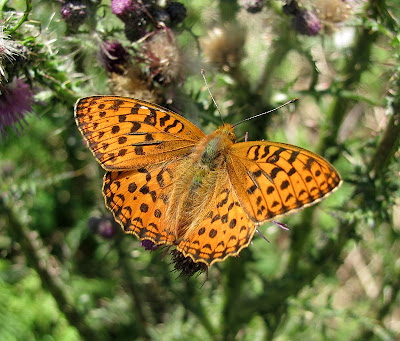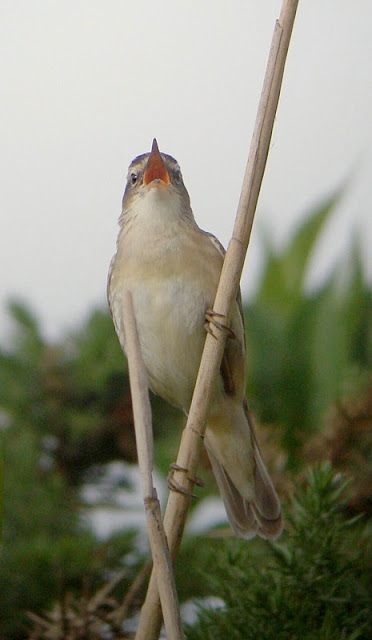A popular clump of thistles, I think there are five Dark Green and one High Brown on them in this shot. At one stage Doug counted no less than twelve individuals on this one clump!
Dark Green Fritillary
Most of the Dark Green Fritillaries were males, like this one.
Females are much more boldly patterned like this stunning specimen.
Underneath the same butterfly.
The green colouring on the base of the underwing gives this butterfly its name.
High Brown Fritillary
All the High Browns seen were males.
A good view of the underside showing the row of brown spots with white centres which are the main distinguishing feature of this species and which give it its name (well the brown part at least, don't know where the 'high' bit originates)
My favourite photo. Enlarge it. It's really cool!
Yesterday news reached me of a summer plumaged Grey Plover on the estuary viewable from the tower hide at Black Hole Marsh. I've never seen Grey Plover in its summer finery, though there have been a couple on patch before, I dipped them both. It was getting on in the afternoon when I heard, but there was time to go and look before work. It was very distant but stunning none the less. I didn't linger more than a couple of minutes as the hide was quite busy and the bird didn't look like coming closer any time soon. I decided to go back after work, which I did at around 8.30. The tide was coming in and the bird had moved a bit closer but it was almost dark so I couldn't take any photos of it. I had the hide all to myself though, which is a novelty these days! This morning I went back yet again, very early, it was still there but still very distant like so....
I'd just love to get close to one of these beauties one day.
( Don't enlarge this...it only makes it worse!!)
( Don't enlarge this...it only makes it worse!!)
On the track from the tower hide, at least this lovely Sedge Warbler was showing well.
This spring we've had a pair of Herring Gulls nesting on our chimney, which hasn't been used by gulls before probably because it has very little room between the chimney pots, making it very precarious for any chicks that hatch. The roof is very steeply sloping too so they would have nowhere to go if they fell off the chimney.... I predicted a disaster! On Sunday the single ( I presume) egg hatched and the chick staggered to the edge of the nest, stumbled and plummeted about forty feet onto the tarmac below. Somehow it survived this. I'm certain its days would have be numbered if left on the ground however hard the parents tried to protect it, so I made a platform on the outhouse roof and moved it onto that. It's only a couple of feet above the back door and for the first couple of days both the parents 'attacked' us every time we went outside. It's mainly bravado on their part though, if you stand your ground they back off and just poo on you instead! Neither parent has attacked for a couple of days now, though they still shout at me a bit. It's certainly not ideal having them there but I couldn't just let the helpless little chick die after it survived the fall.
Dad standing guard while I hide behind the Land Rover!
Look! I've even let them have our coconut doormat to sit on.























4 comments:
Nice Sedge Warbler, they look very very similar to the Black Browed Reed Warblers here (well ours don't have streaks but otherwise very samey).
Glad to hear you're enjoying your chick - we've got three Herring Gull chicks again this year and our neighbour had two, sadly she is down to one. It doesn't take long to get attached and you soon start to feel very responsible - but it's a proud moment when they fledge :)
Thanks Stu, I'll look for one of those on your blog.
Catharine, I saw your Herring Gull chicks on Facebook..so cute! Do the adults ever get used to you and stop pooing on your head though!! ;-)
Dear Karen,
A very interesting web site you have of which I stumbled on. High brown frits are on my list to see as have not seen these for years but due to early season might have to wait untill next year now. Narrow bordered bee hawk moth I have never seen but did find caterpillars of this species in Wiltshire after 5 hours of searching on devils bit scabious a few years ago. Well smart caterpillars they are too!
Will have a closer look at your bee orchid pics as I manage two sites for two varieties in Warwickshire. On page 152 in David Langs orchid book by Wildguides are pictures of all the current bee orchid varieties we have in the UK but a brand new one has just come to light for the UK in Somerset.
Not sure if you have come across any stick insects down your way but I am co-operating with the national recorder for stick insects Malcolm Lee since 2002 so if you do come across any your records would be greatly appreciated. Brambles in urban areas are the places to look. However if you have never seen one I can point you in the right direction as they are in South Devon.
Brian Laney, Botanist and Northamptonshire county recorder for reptiles and amphibians.
Post a Comment